The Who, What, When, Where, and Why.
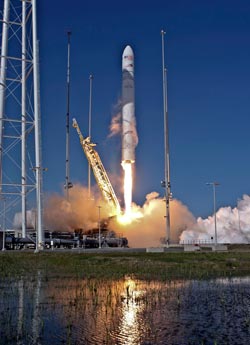
The launch of the Antares rocket from Wallops Island, VA on April 21st, 2013.
Who: Orbital Sciences, MARS (Mid-Atlantic Regional Spaceport), NASA and the VCSFA (Virginia Commercial Space Flight Authority).
What: Design, build and install the hydraulic systems and motion controls to lift the Antares rocket prior to launch and rapidly retract the structure during launch.
Where: Assembly, fabrication and preliminary testing in York, PA. Installation, site-integration, final programming and testing at NASA’s Wallops Island, VA facility.
When: Advanced Fluid Systems began working with Orbital Sciences in the Spring of 2009 and shipped the hydraulic power unit and cylinder assemblies in June of 2011. Programming, installation, testing and training continued through the April 21st, 2013 test launch.
Why: The Antares Rocket is Orbital Sciences’ largest vehicle to date, designed to deliver supplies to the International Space Station.
Challenges and Solutions
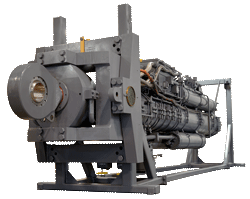
Each of the 51,000 lb cylinder assemblies had the Atos servo valves, ASME rated accumulators and custom manifold assemblies mounted directly to the cylinder. Located just feet from the Atlantic ocean, stainless steel tubing and marine epoxy paint protects the assemblies from the elements.
Challenge: Rapid Retract – Move the 77 ton Antares lift structure 13 degrees in 2.4 seconds during launch.
Solution: Two, 20 inch bore cylinders are driven by large accumulators that are mounting directly to each cylinder to provide 1,060 GPM of fluid per cylinder.
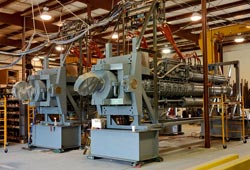
The two 20 inch bore, 269 inch stroke cylinder assemblies at our York, PA facility during assembly and testing.
To power this rapid motion on such a large scale, each of the 20 inch bore cylinders used two custom ASME rated piston accumulators totaling 60 gallons to drive the retract The closed loop system used two larger custom piston accumulators to receive the fluid from the other end of the cylinder.
An added challenge was that the entire retract system had to operate mechanically without electricity after the initial command signal, in case power was lost during lift-off.
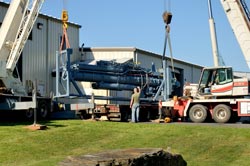
Large casters and custom stands allowed us to assemble, test and ship each 24 ton cylinder assembly with the help of multiple cranes.
Challenge: Redundancy – All hydraulic and electrical systems require an automatic redundant backup system in the event that any component or subsystem failed during operation.
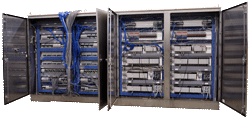
Two 6 foot cabinets contained the redundant Allen Bradley and Delta motion controls that monitored and controlled the 212 sensors and switches; and 87 electrically operated valves.
Solution: A network of sensors and motion controllers monitor the hydraulic and electrical systems. If an issue is detected, the motion controllers can switch to the backup system in less than 40 milliseconds preventing a scrubbed launch or damage to the lift structure during lift off.
The redundant motion controls and sensors continue to operate lift and retract functions even if a sensor, power supply or entire motion controller fails.
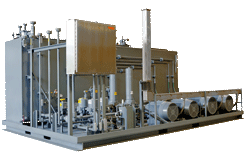
The Antares lift and retract hydraulic power unit used ATOS and Oilgear pumps to lift the Antares Rocket and charge the accumulators for the retraction during launch.
The cylinder and accumulator sensors are triple redundant to compare at least two sensors in case one of the three fails.
The motion controls scope includes:
- 360 Digital Inputs
- 180 Digital Outputs
- 128 Analog Inputs
- 4 Analog Outputs
- 114 Pressure Transducers
- 14 Linear Displacement Transducers
- (17) 24VDC 960Watt Power Supplies
- (24) 24VDC 240Watt Uninterruptible Power Supplies
Challenge: Lift Cylinder Synchronization – The two 20 inch bore cylinders designed to lift and retract the Antares rocket and it’s structure had to be synchronized while lifting the 256,000 lb rocket and structure.
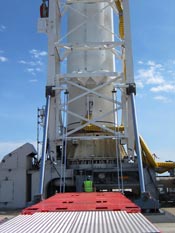
Using dual independent proportional valves and a custom motion profile, the 10 inch cylinder rods are synchronized to within .005 inches of each other while lifting the 128 ton rocket and launch structure.
Solution: ATOS ruggedized high performance proportional valves, Delta RMC151E motion controls and BEI absolute encoder linear position feedback were used to maintain a accuracy of +/- 5 thousandths of an inch during the 256 inches of stroke.
Due to the changing loads when lifting the rocket and the structure from a horizontal to vertical position, we used two high performance proportional valves for each cylinder and created a complex motion control algorithm. Installed independently on the cap end and the rod end, the high performance proportional valves control velocity and pressure simultaneously allowing for a more complex and accurate motion profile.
Our unique, custom piston accumulator design utilized internal transducers that calculated the cylinder rod’s position by measuring the volume of hydraulic fluid inside the accumulator.

